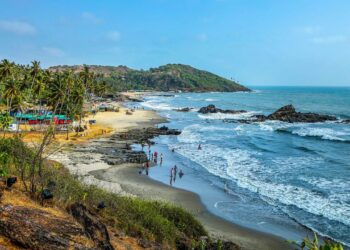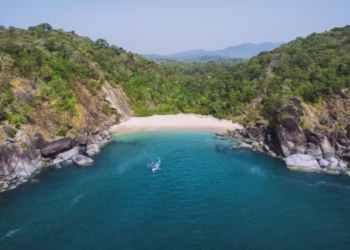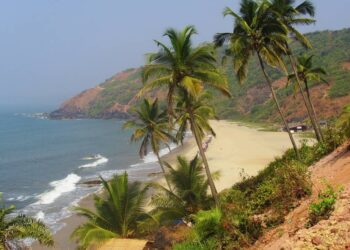Alibaug Beach is a calm seaside spot on the Konkan Coast in Maharashtra’s Raigad district, India. The beach, about 2 kilometers long, has soft golden-black sand and faces the Arabian Sea. It lies only 2 kilometers from Alibaug town and nearly 95 kilometers south of Mumbai, making it a popular weekend trip from the city. Visitors come here for the peaceful waves, lovely sunrise views, and clear sights of old sea forts in the distance.
Fun Fact About Alibaug Beach
A lesser-known fact about Alibaug Beach is its link to ancient Jewish history. It is said that more than 2,000 years ago, the Bene Israel people came to this coastline after leaving their homeland in Palestine to escape hardship. Their boat is believed to have broken near Alibaug’s shore, and those who survived made their home in this area. Over time, they became one of the first Jewish groups to settle in India. Even now, some of their old customs, stories, and a few synagogues nearby still reflect their presence in the region.
History of Alibaug Beach
The story of Alibaug Beach stretches far back in time, starting from when it was a small fishing spot used by early Konkani people. The coast’s good location made it an important place for trade in salt and spices. Archaeologists have found old stone tools near the area, showing that people might have lived here around 4,000 years ago.During the medieval period, Alibaug became an active port under the rule of the Alupa and Yadava dynasties, where merchants from Arabia and Persia came to exchange goods with the local traders.
A major change came in the 17th century when the Maratha Empire rose to power. Chhatrapati Shivaji Maharaj built defenses along the coast to protect it from Portuguese attacks. Later, Kanhoji Angre, who became the admiral of the Maratha Navy in 1698, built the Kolaba Fort in 1710 just off the beach. This strong fort, which can still be reached on foot during low tide, was key in protecting the coastline for many years. Portuguese writings from the 1500s mention the black sands and coconut trees of this region, and by the 1800s, the British East India Company had turned it into a supply station, adding warehouses and a lighthouse.
After India’s independence, Alibaug slowly turned from a quiet coastal town into a popular holiday destination, especially in the 1970s when better ferry services connected it to Mumbai. More tourist facilities came in the 1980s, like a beach walkway and water sports, though coastal erosion became a concern.
Things to Do at Alibaug Beach
Alibaug Beach offers many simple yet enjoyable things to do, mixing relaxation, history, and small adventures.
Watch the Sunrise and Sunset: Because of how the beach is positioned, mornings bring lovely views of the sun rising behind the hills, while evenings glow warmly behind the Kolaba Fort. Many visitors come early to do yoga or walk quietly along the water, and by evening, families and groups often gather to relax or light small bonfires.
Visit Kolaba Fort: Just about a kilometer away from the shore, this old Maratha fort can be reached on foot during low tide or by horse cart, which usually costs between ₹200 and ₹500. Inside the fort, you would be able to see some old cannons, a small temple and a freshwater well. Sometimes local guides also share stories about how the Maratha Navy used this place to guard the coast few centuries ago.
Water Activities: The sea is usually calm, so people often go for parasailing, banana boat rides, jet skiing, or kayaking. Prices are around ₹500–₹2,000 depending on what you do. On quiet days, you might even see dolphins from the boat.
Fun on the Beach: The wide sandy stretch is good for volleyball, flying kites, or building sandcastles. Horse rides along the shoreline are also popular, especially at sunset, costing roughly ₹100–₹300.
Local Food: Beach shacks and small stalls serve coastal dishes like bombil fry, sol kadhi, and prawn curry, usually for ₹150–₹500. Nearby weekly markets sell sweets made from coconut and jaggery.
Heritage Sites Nearby: You can visit Kanakeshwar Temple, a Shiva shrine on a small hill about 20 minutes away, which has over 700 steps. Further south, about 40 km from the beach, is Revdanda Fort, an old Portuguese structure that is still quite striking.
Nature Walks: Guided walks through the coconut groves show local birds like kingfishers, and sometimes olive ridley turtles nesting near the shore. Vrindavan Farm, about 10 km inland, gives a quiet glimpse of organic farming and village life in this part of Maharashtra.
Best Time to Visit Alibaug Beach
October to March
After the monsoon season ends, the weather becomes clearer with temperatures around 20°C–30°C. This is a really good time for water sports, walking to the fort, or just relaxing on the beach. December can get busy with festivals, so booking in advance helps avoid crowds.
April to June
Summers are warm, about 28°C–38°C. Early morning swims or picnics under shade work best. Fewer visitors are around, and stays may be cheaper. By June, humidity starts rising, so the mornings are quite better for exploring.
July to September
Monsoon brings greenery and calm beaches, with temperatures around 25°C–32°C. Boats may not run, but temples and other inland spots are still accessible. Off-season rates are usually lower.
Travel Tips
Tide Check: Low tide lets you walk to Kolaba Fort but can leave you stranded if not careful. High tide may block beach paths.
Respect Nature: This is a turtle nesting area. Don’t use flash while taking pictures and throw trash in bins. Using reusable bottles or bags is better when walking through coconut groves.
Sun and Hydration: The sun can be strong, so wear SPF 50+ sunscreen, hats, and drink plenty of water or coconut water (₹20–₹50). Avoid being out in the middle of the day.










